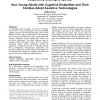Free Online Productivity Tools
i2Speak
i2Symbol
i2OCR
iTex2Img
iWeb2Print
iWeb2Shot
i2Type
iPdf2Split
iPdf2Merge
i2Bopomofo
i2Arabic
i2Style
i2Image
i2PDF
iLatex2Rtf
Sci2ools
CHI
2006
ACM
2006
ACM
Desperately seeking simplicity: how young adults with cognitive disabilities and their families adopt assistive technologies
A surprisingly high percentage of assistive technology devices (35% or more) are purchased, but not successfully adopted. Through semi-structured interviews with a dozen families, we have come to understand the role technology plays in the lives of families who have a young adult with cognitive disabilities, and how families find, acquire, and use these technologies. This study addresses gaps in existing research and informs future efforts in assistive technology design. Design implications include the importance of simplicity not only in technology function but in configuration, documentation, maintenance, and upgrade or replacement; as well as the need for designers to use methods that consider the multiple individuals and stages involved in the technology adoption process. Author Keywords Cognitive disabilities; ethnography; design; technology adoption; assistive technology ACM Classification Keywords H.5.2 [Information Interfaces and Presentation]: User Interfaces - User-centered ...
Assistive Technology Acm | Assistive Technology Design | Assistive Technology Devices | CHI 2006 | Human Computer Interaction |
| Added | 30 Nov 2009 |
| Updated | 30 Nov 2009 |
| Type | Conference |
| Year | 2006 |
| Where | CHI |
| Authors | Melissa Dawe |
Comments (0)

